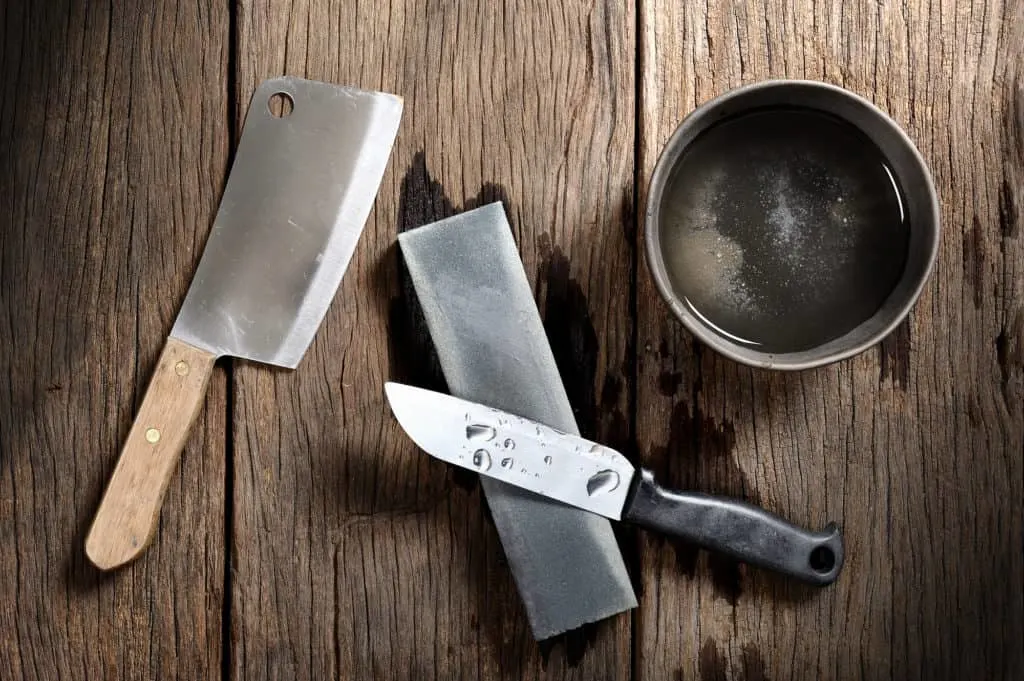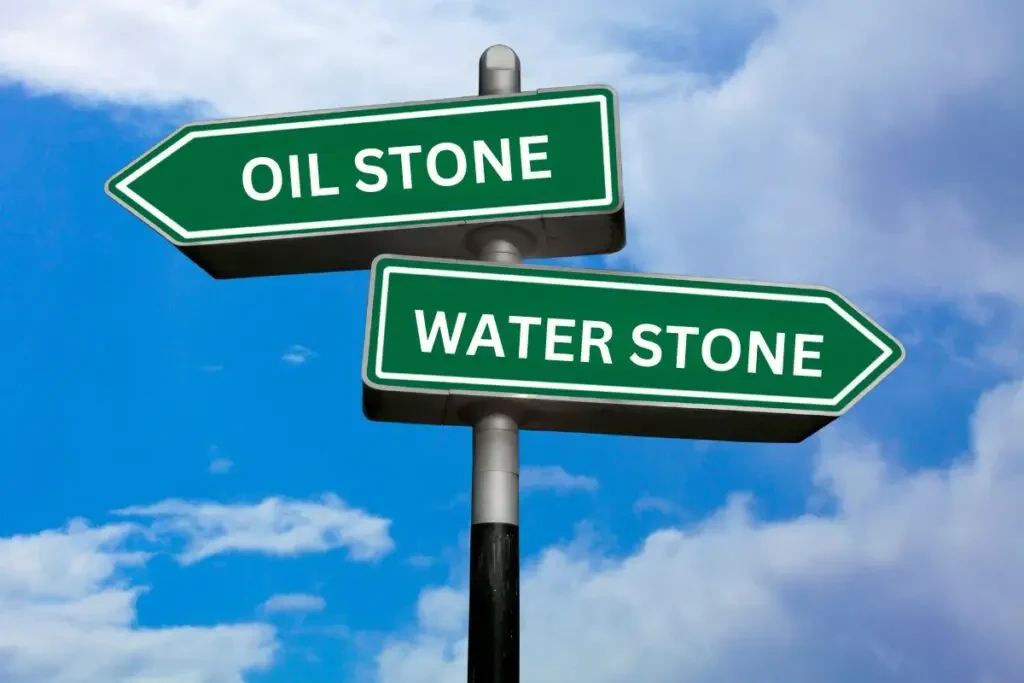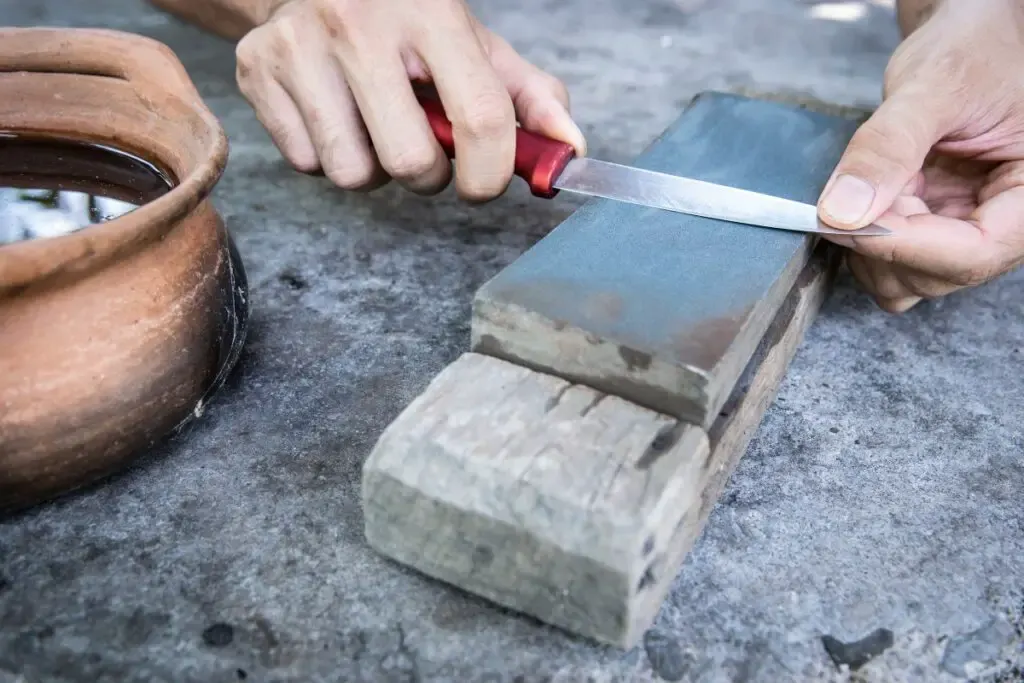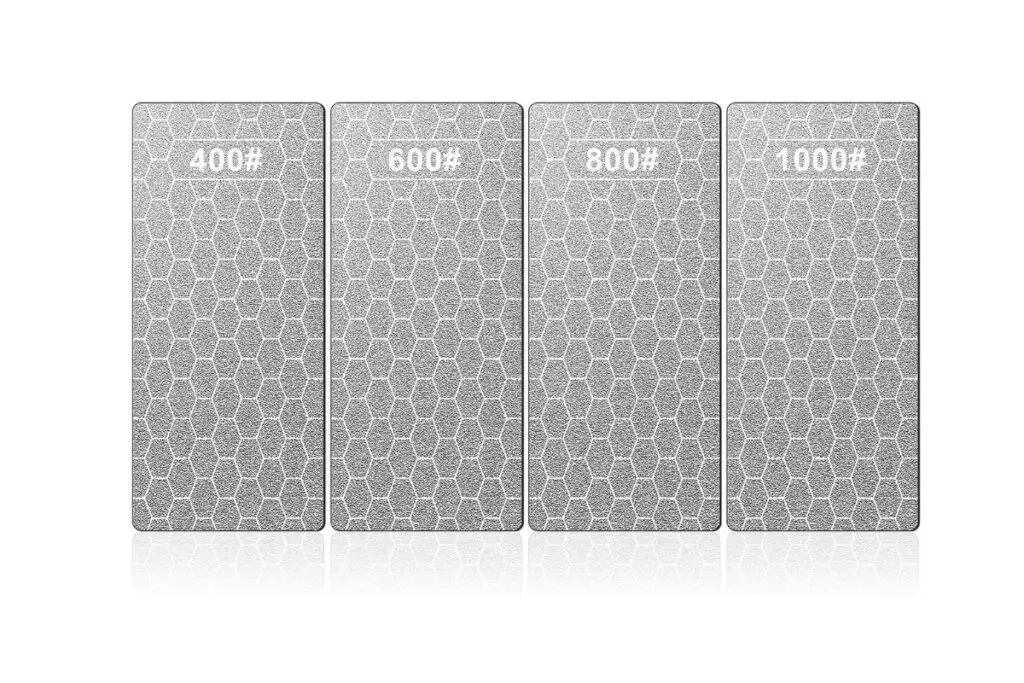As an Amazon Associate, we earn from qualifying purchases with no additional costs for you.
Sharpening stones are the favored method of sharpening many kinds of knives. Kitchen knives, especially Japanese kitchen knives, are most commonly sharpened on sharpening stones. The stones require a certain skill level to be attained to use them effectively.
But once this skill has been acquired, it gives a greater measure of control over the shape and sharpness of the edge of the knife. But what is all the hype about these stones, and what is the difference between an oil stone and a whetstone?
Whetstone is a name that is used to describe sharpening stones. There is no difference between a whetstone and an oil stone because an oil stone is a whetstone. There are different types of whetstones which include water stones, oil stones, ceramic stones, and diamond stones, to name a few.
The topic of sharpening stones is already a fairly confusing topic, especially where newcomers to the knife sharpening game are concerned.
The naming of various types of stones and the incorrect use of the names of the stones has contributed to further confusing an already confused issue. We will try to bring some clarification to this topic by giving the correct naming terminology and discussing the differences between the various sharpening stones.
If you are interested in checking out the best whetstones for your knives we recommend and use you can find them by clicking here (Amazon link).

Oil Stones And Whetstones: The Confusion
Much confusion has come into the knife sharpening sector with the use of the term “whetstone.” A whetstone is not a wet stone. That single letter “h” in the word changes the connotation of the term completely.
The word “whet” means to sharpen. The official definition of the word means to sharpen a knife or a tool by means of grinding or friction.
It is the same spelling when used in the phrase “to whet your appetite,” which means to sharpen your appetite with anticipation.
Because the pronunciation of the word wet and the word whet sounds similar enough to be indistinguishable, the difference in meaning is often only communicated well in written form.
The pronunciation has led to people in the knife sharpening sector incorrectly assuming that a whetstone is a water stone.
This is incorrect because the term whetstone incorporates all sharpening stones that use grinding or friction to achieve a sharp edge on a knife or tool.
The long and the short of it is that an oil stone IS a whetstone!
For the sake of completeness, and if your intended query was the difference between a wet stone or a water stone and an oil stone, we will make a comparison of these two whetstones.
We will also include a brief summary of the other whetstones available that are commonly used among the knife sharpening community.
Oil Stone Vs. Water Stone

Oil stones and water stones are sharpening stones that both come in a wide range of grits, and they use a lubricant as part of the sharpening process.
The purpose of the lubrication on these stones is to lift the waste material or swarf off the surface of the stone so that it does not clog up the stone a reduce the cutting ability of the stone.
With some modern sharpening stones, you can choose which lubricant, either oil or water, that you would prefer to use on the stone. These stones can be made from the same material, but the preference for lubrication is left to the user.
On other stones, the manufacturer will specify whether water or oil is the preferred lubricant for the stone. In most cases, the commercially manufactured stones that are compressed into abrasive stones will work with either oil or water.
Sharpening stones that are made from natural stones will, in most circumstances, be waterstones, and using oil on these stones will render them unusable.
Some manufacturers make sharpening stones that can accept either water or oil as the lubricating mechanism to eliminate the swarf during the sharpening process. With these stones, the manufacturer will indicate that the choice is yours to make.
However, once you select a particular lubricant for the stone, either oil or water, you need to stick with that lubricant for the stone for the lifespan of the stone. You cannot switch to different lubrication once you have used one or the other on the stone.
Generally, you should follow the manufacturer’s recommendation of which lubrication method to use for the particular stone.
TIP: Using a lubricant with a whetstone is a topic that receives much debate in the knife industry. To use or not to use a lubricant? Find out which stones require a lubricant and which lubricant is best for your whetstones in the article below:
Lubricating A Sharpening Stone: The 12 Do’s & Don’ts
Oil Stones
Most stones that are used with oil as a lubricant are stones made from Novaculite, aluminum oxide, or silicon carbide. The stones made from Novaculite are often called Arkansas stones.
The aluminum oxide stones are sometimes referred to as India stones and are a popular whetstone type because they cut fast, produce a good, fine edge, and are relatively cheap.
The silicon carbide stones are sometimes referred to as Crystolon stones. In the past, these stones have also been called carborundum stones.
Carborundum is a term that is not frequently used for silicon carbide stones anymore, but you may still see some manufacturers listing this term on their descriptions.
These stones cut very fast but are generally much coarser and harder than the other stones types, but they are also relatively cheap.
The lower cost of the aluminum oxide stones and the silicon carbide stones make these two types of stones the most common combination of stones to get a full range of grits to use as a whetstone set for knife sharpening.
Water Stones

Water stones range in price from cheap to ridiculously expensive! The most expensive water stones are the ones that are made from a natural rock as opposed to a manmade substance.
The natural rock versions are highly sought after and work really well, but their cost often puts them out of reach of the average person who wants to sharpen their kitchen knives!
There are synthetic or manmade waterstones that are much more affordable, however, and these water stones are generally made from aluminum oxide.
This is similar to the India stones we mentioned in the oil stone section, but the difference in the water stone version is in the binder material that is used to bind the abrasive material together.
The aluminum oxide stones that are produced for use with water are generally softer stones than the ones produced for use with oil as a lubricant.
The softer nature of the stone makes it cut more efficiently because the old layer of abrasive is worn away quicker to reveal a fresh layer underneath.
The disadvantage is that the stones will wear down quicker than the oil stones. The comparative softness of the water stones also means that they are prone to uneven wear, which means they require flattening more frequently than oil stones.
The most well-known and the most expensive water stones are Japanese water stones. These stones are mined from natural deposits of sedimentary rock in the Narutaki District of Japan, north of Kyoto.
The Japanese water stones are normally only owned and used by people that own and use equally expensive Japanese kitchen knives. For this reason, the most common water stones are aluminum oxide water stones.
TIP: You may have wondered if whetstone must be wet or dry during sharpening. This is a common question asked by many sharpeners. Find out the answer in the article below:
Do Sharpening Stones Need To Be Wet? Complete Breakdown
Oil Stone Vs. Water Stone
So when it comes to making a choice between oil or water, which should you select as your stone and lubricant combination of choice.
Let’s take a quick comparative look at these two stone types and lubricants, which may help you make a selection based on your circumstances and requirements.
For the purpose of comparison, we will focus on the water stones that are made from synthetic aluminum oxide rather than the expensive natural versions.
| Oil Stones | Water Stones | |
|---|---|---|
| Cutting speed | Oil stones have a relatively slow cutting speed, making the sharpening process longer. | Water stones cut faster than oil stones, making the sharpening process faster. |
| Durability | Oil stones are harder and wear much slower. Oils stones wear evenly. Less need for flattening. | Water stones are softer, which makes them wear out faster. Prone to uneven wear. Require more frequent flattening. |
| Price | Being constructed from manmade products, the oils stones are relatively cheap, other than the very hard, black Arkansas stones. | Manmade water stones are about the same price as oils stones made from the same materials. Natural rock water stones are extremely expensive. |
| Mess factor | Oil is messier to clean up after sharpening, and it is also a factor that makes the oil stones are less portable for use in the field. | Water as a lubricant is easy to clean up after sharpening. Water is easier to use in the field, which makes water stones more suitable for portable |
TIP: Using leather for stropping knives is quite popular among sharpeners as the finishing step in the sharpening process of the knife. Check out the DIY guide about stropping knives with leather in the article below:
How To Sharpen Knives With Leather: A DIY Guide
Personal Preference In Whetstones
As a beginner in the knife sharpening world, you may still be unsure whether to choose water stones or oil stones to start with to sharpen your knives and tools.
Even though the water stones wear down faster than oil stones and have a tendency to wear unevenly, they don’t wear down so dramatically that you need to replace them frequently. They just wear faster than the oil stones.
This fact, and the fact that the water stones make the sharpening process faster and cleaner, my recommendation is that you start with a set of aluminum oxide water stones to whet your appetite for knife sharpening. See what I did there?
It will be easier for you to learn the skills required for sharpening on a whetstone using a water stone rather than an oil stone.
Once you have learned the skills and become proficient with sharpening stones, you can give oil stones a try and see if you prefer them to water stones.
TIP: Are you looking to buy a new whetstone? Check out our recommendations (we personally use the first three ones):
Our PRO choice whetstones combo (Amazon links):
- Fixing stone: Whetstone SHAPTON Ceramic KUROMAKU #320
- Sharpening stone: Suehiro CERAX soaking whetstone: Medium #1000
- Finishing stone: Whetstone SHAPTON Ceramic KUROMAKU #5000
Our budget choice (Amazon link): Sharp Pebble Extra Large Sharpening Stone Set
What Grit Stones Should You Start With?
Whether you choose to start with oil or water stones, you are going to need a set of stones ranging in grits in order to completely sharpen your knives.
The grits of stones can be divided into three main categories; fixing stones, sharpening stones, and finishing stones.
- Fixing stones.
These are coarse stones in the grit range of 120-grit to 300-grit. These stones are used to repair knives with very damaged edges such as chips and gouges in the cutting edge.
They are very coarse and remove a lot of material very quickly, but you will need to go to higher grit stones to get the knife sharp.
- Sharpening stones.
These are less coarse stones in the grit range of 400 to 3000-grit. You will need a couple of stones in this category with increasing grits to put a sharp edge on your knives.
- Finishing stones.
These are stones that are very fine and will polish the cutting edge of the knife, sometimes to a mirror finish. The grit for the stones in this range is 4000 to 12 000-grit stones.
Stones in the range of 4000 to 6000 grit will give a low to a medium mirror finish, while stones in the 8000 to the 12000-grit range will give a full mirror finish to the edge.
Often, the stones come in sets where one grit is back to back with another, higher grit. Buying these styles of stones works out cheaper than buying individual grits.
A good range of grits to start out with for your oil stones or water stones would be the following.
- A fixing combination stone of 120-grit / 300-grit
- A sharpening combination stone of 400-grit / 1000-grit
- A finishing combination stone of 4000-grit / 6000-grit
These three stones will give you a good working whetstone set, whether oil stones or water stones. You will be able to repair damaged knives, sharpen knives and hone knife edges to be razor-sharp!
TIP: Choosing the right whetstone can be tricky sometimes so that’s why we wrote a complete guide about buying whetstones. So if you are looking for a great whetstone check out the ultimate guide in the article below:
How To Choose And Buy A Whetstone: The Ultimate Buyer’s Guide
Other Whetstones
Of course, there are other stones to choose from in the whetstone categories apart from oil stones and water stones.
Other types of whetstones include diamond stones and ceramic stones. Each of these stones has its advantages and situations where they perform better than other stones.
Diamond Whetstones

Diamond whetstones use a coating of industrial diamond chips as the abrasive compound. The diamond chips are usually bonded onto a metal plate which acts as the base for the stone.
Many people would expect that the fact that these stones use diamonds as the abrasive, they would be very expensive.
This is not the case, however, and these whetstones are pretty affordable, although they are generally more expensive than water stones or oil stones. Diamond whetstones last a long time, so the additional expense is warranted for the additional longevity.
They also offer a number of advantages over the other whetstone types.
- Diamond whetstones stay flat and don’t need to be flattened like other oil stones or water stones do.
- The diamonds are very efficient cutting abrasives, so they work fast.
- Diamond stones can be used dry, with no lubricant at all, which makes them great as a portable sharpening option out in the field.
- They can be used with water as a lubricant if you so wish.
Diamond stones are available in mono-crystalline and poly-crystalline forms. Of the two, mono-crystalline diamond stones will have better durability.
If you are interested in diamond stones as an alternative, the following grits would be recommended as a complete set of diamond stones to do all the work you need to do on a knife edge.
- Fixing stone. A diamond stone of 400-grit.
- Two sharpening stones. One of 600-grit and one of 1000-grit.
- A finishing stone. A diamond stone of 1200-grit.
Ceramic Whetstones
Another manmade style of whetstone is the ceramic whetstone. While these stones are whetstones, they are of a higher grit and are generally considered more as finishing stones rather than sharpening stones.
Ceramic stones do a very good job at polishing and honing the edge of a blade, but the blade would have had to have been sharpened on one of the other stone types first.
Quick Summary Of Oil Stone Vs. Water Stone
What is the difference between an oil stone and a water stone? Oil stones typically use oil as a lubricant and are often made from materials like Novaculite, aluminum oxide, or silicon carbide. Water stones use water as a lubricant and can be made from natural rock or synthetic materials like aluminum oxide. Oil stones tend to cut slower and are more durable, while water stones cut faster but wear out more quickly.
Can I use both oil and water on the same sharpening stone? Generally, once you choose a particular lubricant for a stone, either oil or water, you should stick with that lubricant for the lifespan of the stone. Following the manufacturer’s recommendation is essential, as using the wrong lubricant can render the stone unusable.
Are water stones better than oil stones? Neither is objectively better; it depends on personal preference and specific needs. Water stones tend to sharpen faster and are easier to clean, while oil stones are more durable and wear evenly. Beginners might find water stones more accessible, while professionals might prefer the characteristics of oil stones.
What grit stones should I start with for sharpening? A good range of grits for either oil stones or water stones would include a fixing combination stone of 120-grit / 300-grit, a sharpening combination stone of 400-grit / 1000-grit, and a finishing combination stone of 4000-grit / 6000-grit.
Are there other types of whetstones besides oil and water stones? Yes, besides oil stones and water stones, there are other types of whetstones, including diamond whetstones and ceramic whetstones. Diamond whetstones use industrial diamond chips as the abrasive compound, while ceramic whetstones are often used for polishing and honing the edge of a blade.
Is a whetstone the same as a water stone? The term “whetstone” refers to any sharpening stone that uses grinding or friction to sharpen a knife or tool. A water stone is a type of whetstone that specifically uses water as a lubricant. The confusion between the terms often arises from the similar pronunciation of “whet” and “wet.”
Conclusion
In conclusion, All sharpening stones are whetstones, but there are various types of whetstones, of which oil stones are one.
The choice between oil stones and water stones is very much a personal preference, but if you are a beginner, it is recommended that you start with water stones.
This is because they sharpen the knives faster, and there is less mess and fuss when using these stones.
If you are in need of truly portable knife sharpening solutions, then a set of diamond stones would be the preferred solution since it is possible to use these stones dry or with a little water.
TIP: Speaking about the other whetstones, did you hear about Kuromaku whetstones and Glass stones made by the Shapton company? We personally really like these whetstones so check out their comparison in the article below:
Shapton Kuromaku Vs. Glass Stone: What Works Best?
